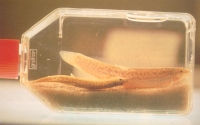1‧Induction and development of triploidy in oysters and small abalone
A comparison was done of the parameters to induce triploid oyster and small abalone along with an investigation of the growth of artificially induced triploid larvae into oysters and small abalone. Pond and sea shore triploid eyed larvae and young shell-on oysters were imported from Seattle, WA, USA as reference. Meanwhile the influence of water quality in the natural habitat was studied for preevaluation of environmental parameters concerning fouling and growth of triploid oysters and small abalone. Regarding the analysis of triploidy, a flow cytometer method with the use of a DNA analysis kit and laboratory protocol was developed to determine the percentage of population in a batch of larvae or adult oysters. It is very helpful to utilize these technologies to increase the productivity and economical importance of shellfish in future.
2‧Cropreservation of embryos/larvae/sperm of economically important shellfish
Freezing protocol and vitrification protocol were tested repeatedly to meet the species-specific requirement. The application of origrannabke freezer strengthened the high accuracy and encouraged reproducibility of the successful result in cryopreservation of embryos/larvae of oysters and hard clams. In addition to this, cryopreservation of sperm of small abalone was highly recommended becaused of the particle need and excellent fertility record of
short and long term preserved sperm in refrigerators and liquid nitrogen containers respectively.
3‧Cryopreservation of embryos/sperm of finfishes
A scientific approach was carried kout to establish embryos cryopreseration protocols in zebra fish and finger fish. This was offered as a sound reference for similar studies of other fish and a subsidiary tool for gene transfer researchers. Further research is still on going with a systematical strategy to improve the overall survival rate in order for this approach to be successful. Studies on cryopreservation of sperm of seven species of economically important fishes gave the rather encouraging result in terms of high frozen-thawed survival and fertilization rate, feasible on to three year long term preservation, practical application in private farm and laboratory as well as international scientific reputation.
4‧Molecular biotechnology study in loach
An antifreeze protein gene promoter was taken from an ocean pout and linked to a chinook salmon growth hormone cDNA that was then successfully introduced into loach sperm via electroproration. Genomic Southern Blotting demonstated the presence of a positive band of DNA from transgenic loash. The average weight gain was 2.5 folds higher than that of control group by the 161th day. It is an inital break through of using fish sperm treated with electroporation as a mass gene transfter carrier.

 The loach with growth hormone gene transfered via electroporated sperm has faster growth th
ean the control one.
Field work of cryopreservation of fish sperm.
The loach with growth hormone gene transfered via electroporated sperm has faster growth th
ean the control one.
Field work of cryopreservation of fish sperm.